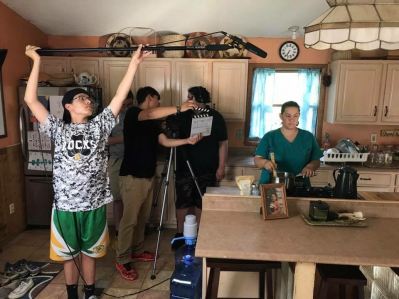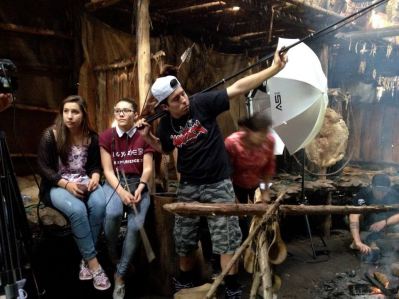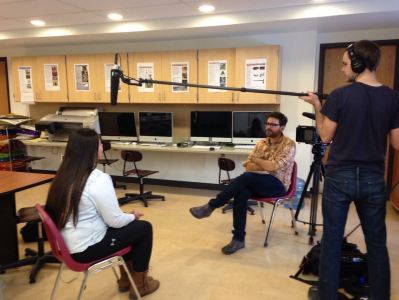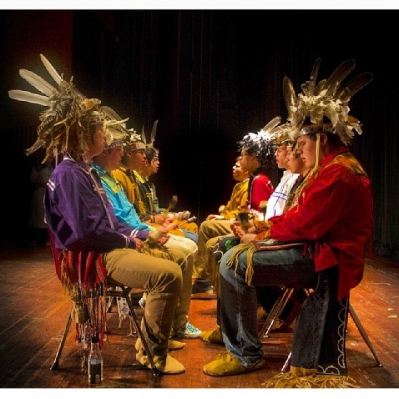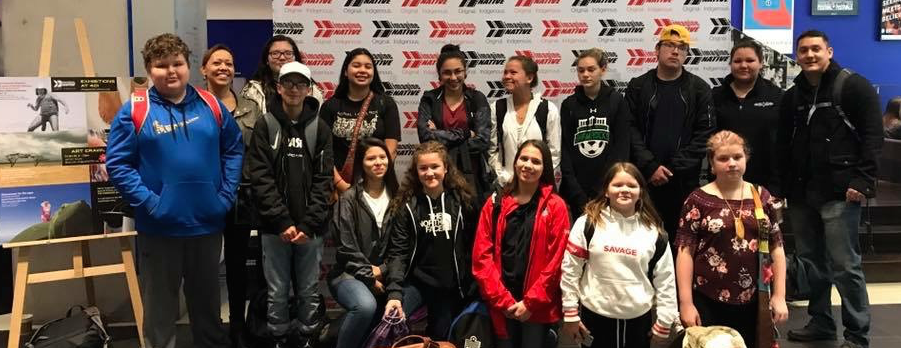Salmon River Central School District - Empowering Native Youth through Film Production
By Karlie Flood, Intern, Office of Educational Design and Technology, New York State Education Department, EdTech@nysed.gov
Students at Salmon River Central School District are telling their own stories, thanks to Katsitsionni Fox, a Cultural Specialist and Teacher who developed a Native Film class that encourages project-based, hands-on, visual learning. Students are provided the opportunity to practice skills such as collaboration, critical thinking, and problem-solving as they take turns directing, casting, writing, and editing their own films. Through film, students can tell their stories through their own eyes while countering dominant Native American stereotypes and providing resources for other Native communities.
Katsitsionni Fox, an educator and a filmmaker, chooses to incorporate film in an educational setting because she knows the power of filmmaking. She is the owner of Two Row Productions, a Native-owned media productions company, where she produced the award-winning film Ohero:kon - Under the Husk in 2016. She recalls being deeply touched by the feedback she receives from audiences at film festivals and screenings.
“There are so few films out there about Native People, and the films that are out there are most often not through our own lens. They are not filmed or produced by us. There is such a need for [film] to promote cultural understanding and appreciation. I felt it was important that we start giving this tool to the youth to start telling their own stories through their own eyes,” Fox said.
Fox has taught at Salmon River School for 18 years. She is the Director and Cultural Specialist for the Title VI Program, which funds programs such as Native Studies, Native Film, Mohawk Club, and Mohawk Language. According to Salmon River’s Central School District’s Title VI page:
“Title VI is a federally funded formula grant program that currently services 1,017 Native students in the Salmon River Central School District. Salmon River has the highest population of Native Students in New York State, with 66% of the student body. Our program continues to provide courses and services that support Mohawk Language and Culture Instruction.”
The Title VI Program at Salmon River has existed since 1973. Salmon River Central's Title VI Program began offering an elective course, Native Film, fourteen years ago. The students have produced dozens of short films, which are screened at an annual student film festival. Through this course, students examine Native American stereotypes in film, and are provided the opportunity to create films with their own unique, original perspectives. Salmon River has committed to preserve the Mohawk tradition, culture, and language within the school system. The elective courses that Fox teaches are Native Film, Native Studies, and Haudenosaunee Arts. The Native Film class is offered as a full year course for grades 9-12, and half a year for 8th grade students.
Fox oversees programming in the district that relates to Native culture and language. Prior to teaching the Native film class, Fox was coordinating film projects with the Mohawk Language teachers at Salmon River School District. Shortly after, she offered to develop and teach a Native Film course. She enjoys using film to teach, as many of her students are visual learners. When I asked why she chose this channel of learning instead of traditional writing assignments, she reminded me that her students are still incorporating writing:
“Filmmaking is visual storytelling,” Fox noted. “The students still need to know how to develop a story, but they’re learning how to do it visually, and along the way, they’re learning how to operate different cameras, work the lighting, the difference between microphones, and how to edit their work.”
Fox describes film as a vehicle to counter and challenge stereotypes often personified in the media and Hollywood films. In “Art and Cultural Understanding: The Role of Film in Education,” professor Daniel Nadaner argues that “the thoughtful use of the expressive aspects of film enables the filmmaker to work against stereotypes” and can “help students understand the thoughts and feelings of persons from cultures other than their own” (Nadaner 6).
Above, right: High school students filming a project for their Native Film Class. Above, left: The Native Film class filming the short film 7 Dancers. Below, left: Guest Filmmakers from Flat Bush Pictures filming Keepers of the Game. Below, right: A still photo from the production of Circle of Respect.
However, not every project focuses on culture. Every year, her eighth-grade students work on a project called “My Dream,” where they interview each other about their dreams for the future and present them in video format. The students learn how to do three-point lighting, conduct an interview and use a lapel microphone. Fox always looks forward to the high school class’ end of the year project, where the students produce a single short film while being involved in the whole process. They take turns practicing a variety of roles, including writing the script, casting the characters, and adjusting the audio and lighting. They film, direct, and edit the video, while collaboratively switching between roles and scenes. In November of the following year during Native Heritage Month, the entire school gathers to watch the video.
“Each student will pick up on a certain thing: maybe they’re good at writing the script, or one student really enjoys directing. You see their individual talents shine through the class, and I really appreciate that because we’re all individual people. Even though we’re learning the same thing, each student has an opportunity to shine at something,” Fox explained.
Fox prioritizes the learning process over the quality of the product, although the final products her students produce are quite impressive. Most of the videos made by her students highlight Mohawk culture, such as Native American displays, fashion, and traditional dancing and art. They post videos to their YouTube channel “Mohawk Media Creations.” Often, the videos include drumming, music, or singing. Some videos are playful, like their “zombie flick” featuring the school’s lacrosse team, but most of her student’s videos focus on pertinent, society-wide issues, such as prescription drug abuse. A video declaring “I’m not a costume,” addresses the offensive popularity of the Native American costume. A music video created by her students about the importance of water has been viewed over 146,000 times, sparked by the national attention to the DAPL pipeline in North Dakota which cuts through a Sioux reservation.
Her students’ films have won multiple awards. In 2006, the National Museum of the American Indian recognized seven films across the country, and three of the films they chose were created by her students. In 2013, her students won third place in the national student video contest "Speak the Truth to Power.” The video centered around bullying and the Human Rights Defender Jamie Nabozny. Their video featured the "Sken:nen Ratiha:wi" initiative at the Mohawk School, an interview of Angela Elijah, as well as footage from the tree planting at Salmon River High School. The video also included a dramatization of a student being bullied.
In 2017, the Salmon River Native Film Class won third place in a national film competition, “Storytelling about Health and Wellness in American Indian and Alaska Native Communities,” sponsored by the National Indian Health Tribal Health Research Office. Five students from her Native Film Class worked together to create the film, called Ohero:kon: Rites of Passage - Creating Health and Wellness, entering the competition as a class project. They chose to focus on how the Ohero:kon passage rights ceremony brings health and wellness to their community. Over 30 films were submitted and many of them were produced professionally.
“The students have created countless films over the years and they are all well-received in both the community and on YouTube. It is so rewarding for me to see the students express themselves and their culture through film,” Fox expressed.
So far, Fox has been able to accommodate anyone that has taken the class; peers are very helpful, and Fox provides extra help if necessary. She believes film can be incorporated into any class, and that videos are accessible to anyone; “You can do projects like this using an iPhone and iMovie. There are so many resources online, and the students know more than you think, so you can incorporate their knowledge in the classroom,” Fox revealed. She enjoys incorporating Mohawk language in the film, and once taught a class with all Level 4 Mohawk students. The films were entirely in Mohawk language. “There are so few resources in the language that it’s not only helpful for this community, but other communities who are looking for resources,” Fox said.
Fox brought her students to the imagineNATIVE film festival in Toronto, the world's largest Indigenous film and media arts festival. Here, students were exposed to virtual-reality film, other student’s work, and many had an opportunity to experience a film festival for the first time. “Any worlds that you can open up to them is good,” Fox added.
Fox’s film class has real implications on her student’s futures and careers. Several of her students have acquired jobs because of the skills they gained from the classroom. One student went on to Cornell University and was offered a student job in film work because she had practical experience in film production. Several of her students have worked at the local TV station–Akwesasne TV—and another worked as an AV technician at the North American Indian Traveling College.
As Nadaner said, “to begin to imagine life in another culture, we need images and ideas to fill our minds” (Nadaner 6). Throughout history, Natives have routinely been the backdrop instead of the main characters in film. Today, Natives remain misrepresented, oversimplified, and stereotyped in both popular culture and society. However, through film, Natives can create their own realities; “It’s about bringing those Native, main characters forward. Now the students are in the driver seat to decide the story and how they’re going to tell it,” Fox stated. Video by video, the students at Salmon River Central School District are pushing us all one step closer to overcoming cultural stereotypes.
Contact
- Katsitsionni Fox, Teacher, Salmon River Central School District, kfox@srk12.org
Works Cited
- Daniel Nadaner. “Art and Cultural Understanding: The Role of Film in Education.” Art Education, no. 4, 1981, p. 6. EBSCOhost, doi:10.2307/3192542.
- “Title VI.” Salmon River Central School District.






